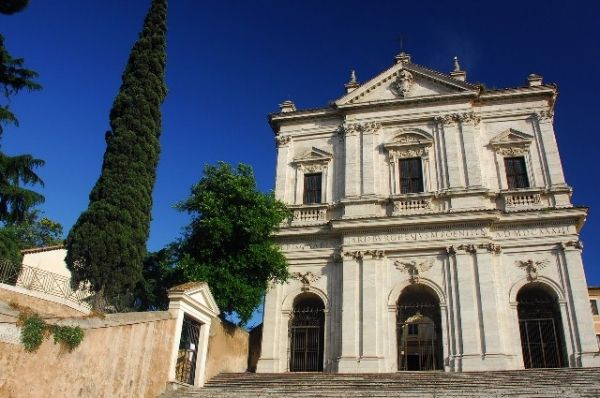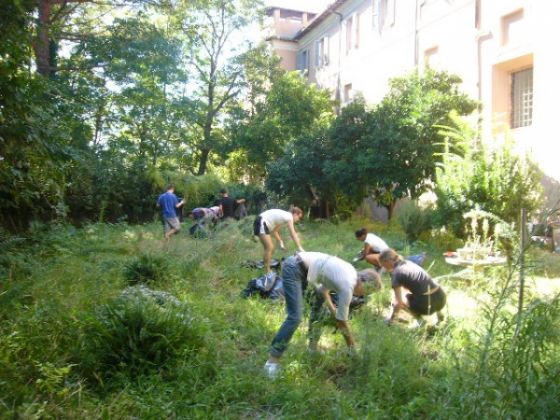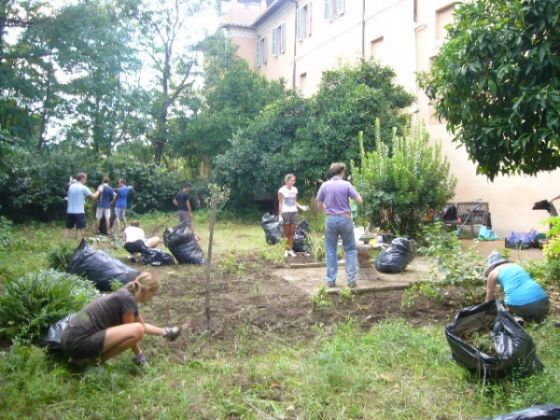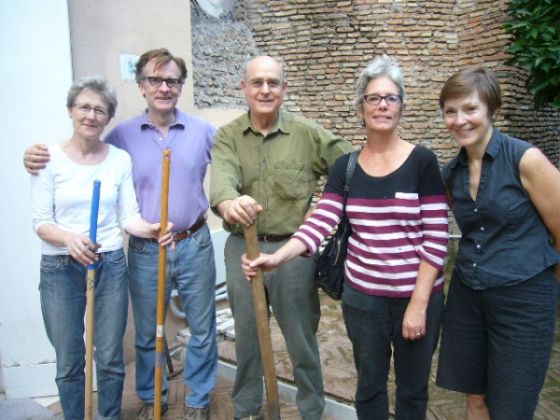An ecumenical gardening project in the heart of Rome.
The monastery and church of S. Gregorio al Celio was founded by Pope Gregory around the year 575, when he converted his family’s patrician villa into a monastery. It was from this very site that Gregory sent Augustine and 40 monks to the British Isles to become the first Archbishop of Canterbury and re-evangelise the English, in 597. It has therefore often been the historic meeting place of the pope and the archbishop of Canterbury, representatives of those two branches of the Christian Church, the Roman Catholic and the Anglican. In November 2010, when Archbishop Rowan Williams came to Rome, he celebrated vespers at S. Gregorio with Pope Benedict.
S. Gregorio is situated among the monuments of Rome’s former glory, with the Palatine hill directly opposite to the north, while the Circus Maximus lies on lower ground to the left. The Colosseum is a short distance to the right, in plain view. The gardens of the monastery have been neglected for a long time as the number of monks resident there has declined.
In June 2012, five Anglicans metin the garden of S. Gregorio for their pre-ordination retreat. They perched their rickety chairs on uneven bricks at the side of a large rectangular area, overgrown with high grasses; fruit trees were bowed over with unpicked oranges, some of which lay rotting on the ground. The five men and women shared the stories of the paths that had led them to that place as the sun was setting. Someone remarked how sad it was that the former monastery garden seemed so forlorn.
When Verna Veritie, one of the ordinands, died later that summer in a tragic fall, another member of the retreat they had shared decided to restore the garden as a memorial to her. Peter Hughes, the prior of the Camaldolese (Benedictine) community residing at S. Gregorio, embraced the idea that a group of ecumenical volunteers should begin to work there.
In September 2012, clearing and preparation began; after three long sessions that autumn the group waited for their supervising landscape gardener, Beth Blosser, a member of All Saints’, to finish designing a new garden plan complete with labyrinth, pergola, fountain and Biblical plants. Blosser researched previous garden designs in the history of that piece of land to present to the city’s archaeological authorities, a required approval process. The existing watering system and lighting also had to be surveyed. All the formalities were met and the papers were delivered. After eight months of waiting, approval was denied. “Too elaborate,” the city said.
After this setback, Blosser and the consulting architect returned to the task of designing a plan that would be faithful to their vision of what the garden could become, but pass the bureaucratic obstacles that still seemed daunting. Much to everyone’s delight,the revised set of plans was recently approved. The committee is now drawing up a budget and pricing the paving of new paths and the seeding of the lawn.
Because of the enforced pause in gardening at S. Gregorio, it was suggested that the ecumenical group might meanwhile continue its work at the Angelicum Pontifical University where there is another monastic garden. Father Loic-Marie Le Bot, the then prior of the Dominican community at the Angelicum, enthusiastically welcomed the ecumenical group’s help. About 1,200 students, many from India and poorer countries of the world, attend classes at the university in theology, philosophy and English. Its building dates from 1575, when it housed a community of Dominican nuns.
In February 2013, Jill Rios, wife of the recently-arrived rector of St Paul’s Within the Walls Episcopal Church Austin Rios, who is active at the Joel Nafuma Refugee Center there, initiated a new element that has become an integral part of the gardening project. At her suggestion, All Saints’ Anglican Church and St Paul’s decided to pay three refugees from Afghanistan for their work alongside the other volunteers. It was an attempt to help three of the many, many refugees who are unable to find work in Rome in the current dismal economic climate.
Abdullah left to join a friend in the Veneto last summer. Hamid and Syed continued to work in the garden through the autumn and winter, as well as at St Stephen’s High School on the Aventine as part-time gardeners.
Hamid, 27, was born in Kabul, the son of a middle-level officer in the Afghan army. Their large family lived comfortably. Then, in 1993, the Mujahideen arrived and imprisoned Hamid’s father for two years. Having managed to obtain his release, the family fled after midnight in their car to Iran, driving continuously until they reached Tehran. As Afghan refugees there were not allowed to attend school, and jobs were non-existent, Hamid made his way to Italy, where he enrolled in Italian middle school (he graduates in June) and is intent on pursuing his education.
Syed is 30. He was born in the village of Sayed Wali, near Ghazni in the central-eastern Qarabagh district of Afghanistan. His father was a mullah; Syed had two brothers and two sisters. When rival militias bombarded their town in 1993-4, one of his brothers was killed in the collapse of their house and his sister, then aged only one, was wounded, remaining in a coma for 40 days. She is severely disabled now. In order to try to protect his family, Syed learned how to assemble semi-automatic weapons at a young age, as if that were normal. He worked to help his family as a car mechanic, waiter, taxi driver. When he tried to open a private language centre in 2010, the Taliban sent him two threatening letters, saying he was subverting the religious education of the people. They were determined to close his school and drive him out. Syed fled to Italy, where he was able to work part-time as a translator for organisations helping the refugee community in Rome, and as a gardener. He dreams of being a teacher, of earning enough to be able to help his family, now based in Pakistan, in their poverty and sickness. He clings to the saying attributed to Mohammed: “Seek knowledge from cradle to grave.” He believes that we should work for the good of others.
The ecumenical gardening project now includes volunteers from the Anglican, Episcopal, Methodist, Lutheran and Roman Catholic churches of Rome as well as students from St Stephen’s School. The project has drawn people who have no gardens themselves, but wanted to contribute in this way to two places where the spiritual life has been lived for centuries, and where places of beauty and repose are now being recreated for the monks; for the students who live at S. Gregorio and the students who attend classes at the Angelicum; for those who come to stay as guests at S. Gregorio; for others who come there on retreat.
The work continues. If you would like to send funds to help with the purchase of plantings or to contribute to the work of the refugees in the gardens, please contact the Rev’d Dana English, assistant curate at All Saints’ Anglican Church, at dlenglish@aya. yale.edu.
Dana English
This article first appeared in the June 2014 edition of Wanted in Rome.



























